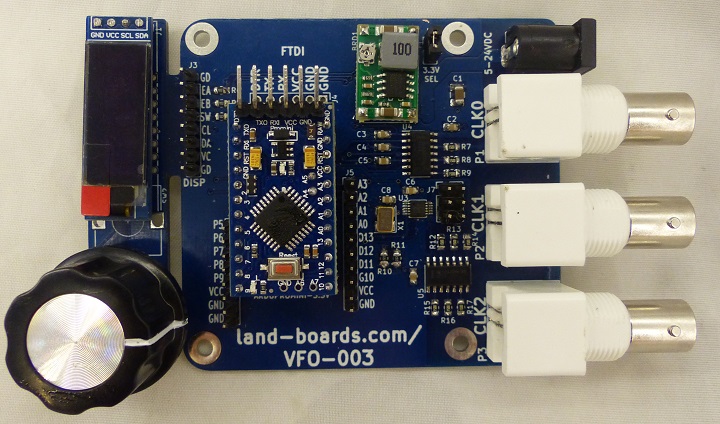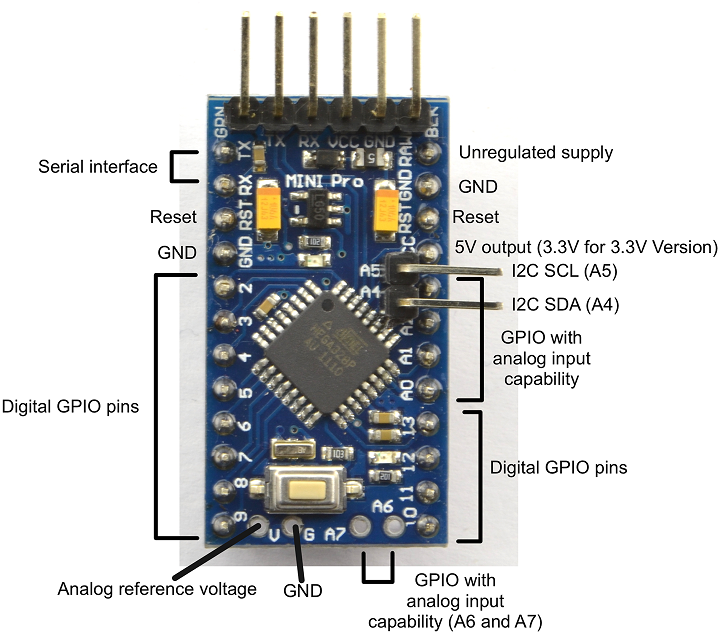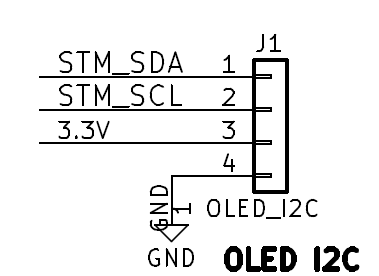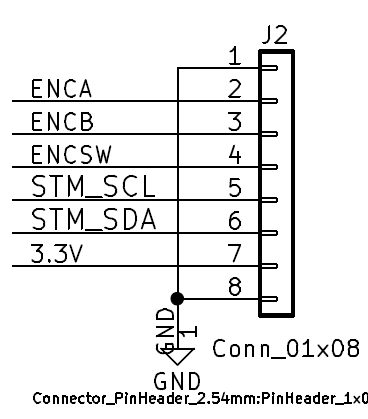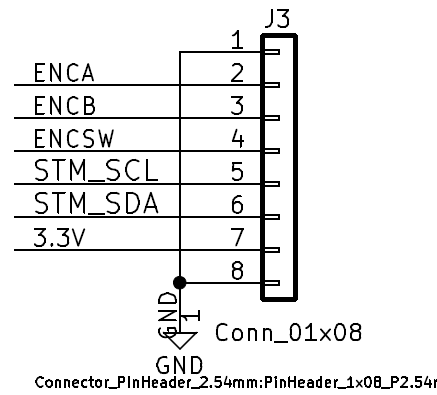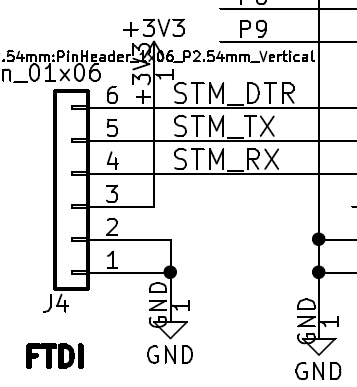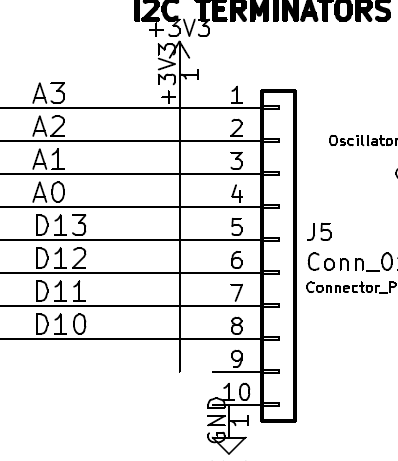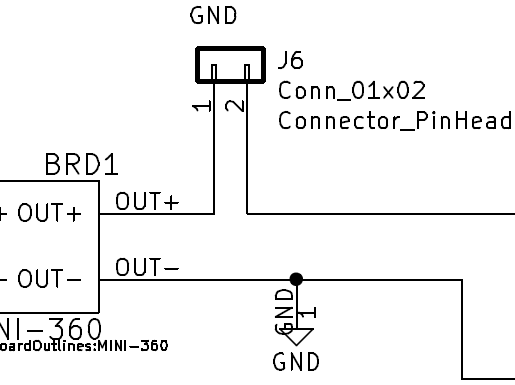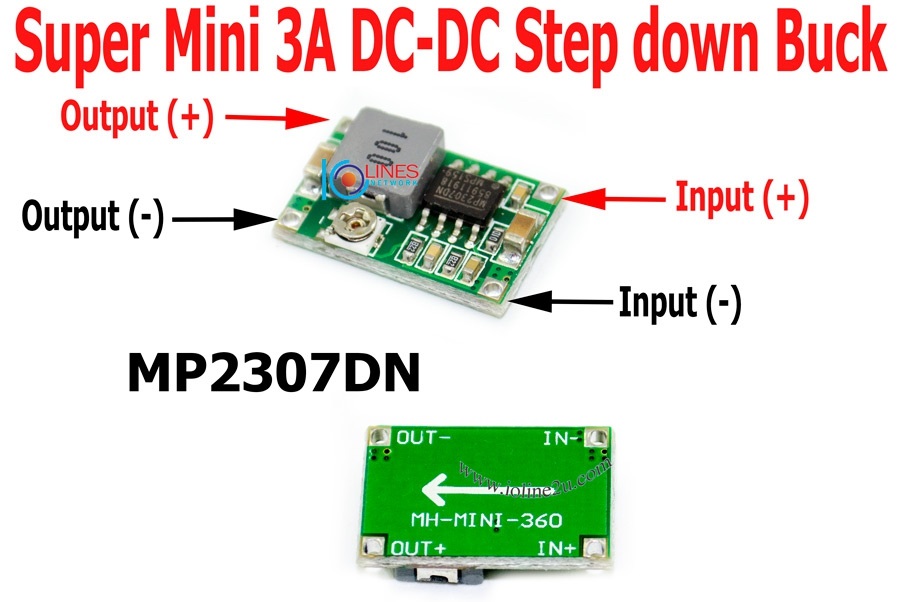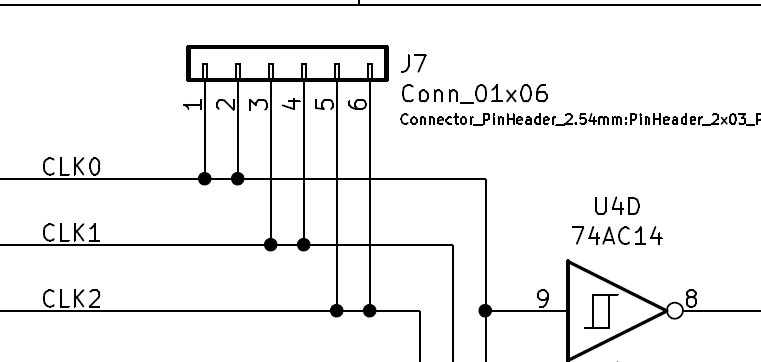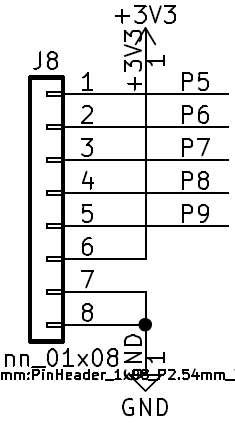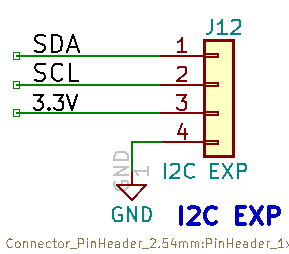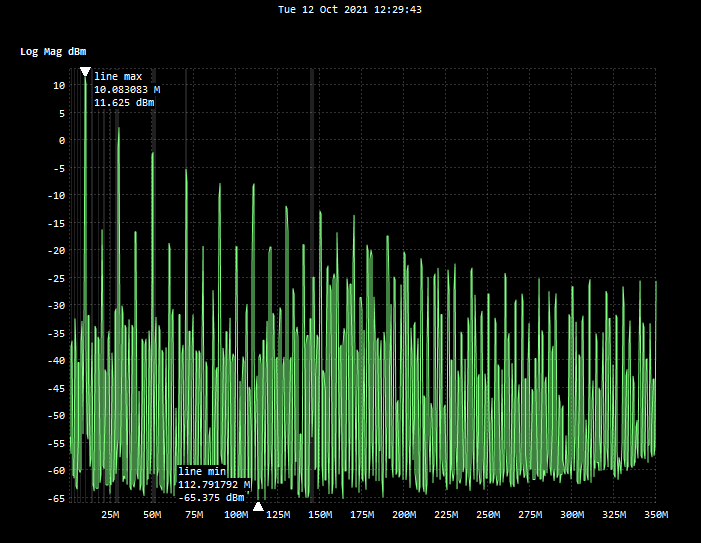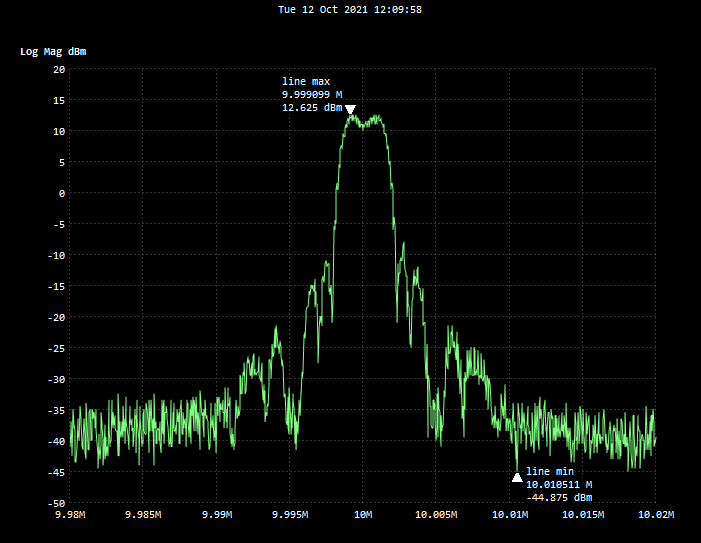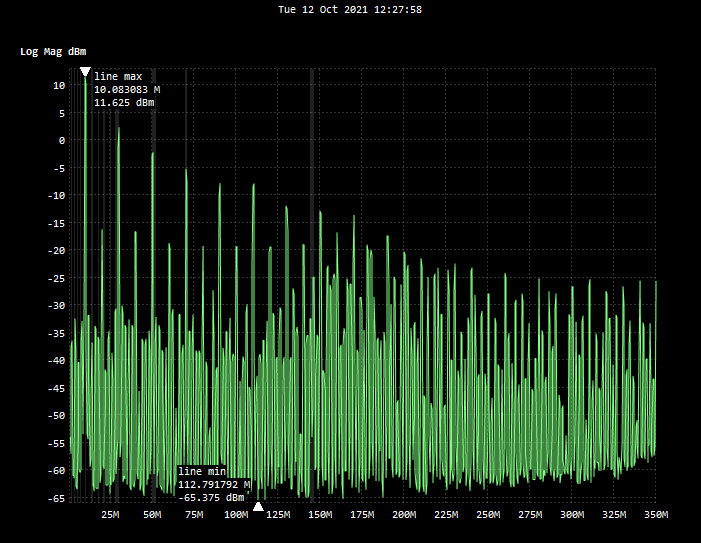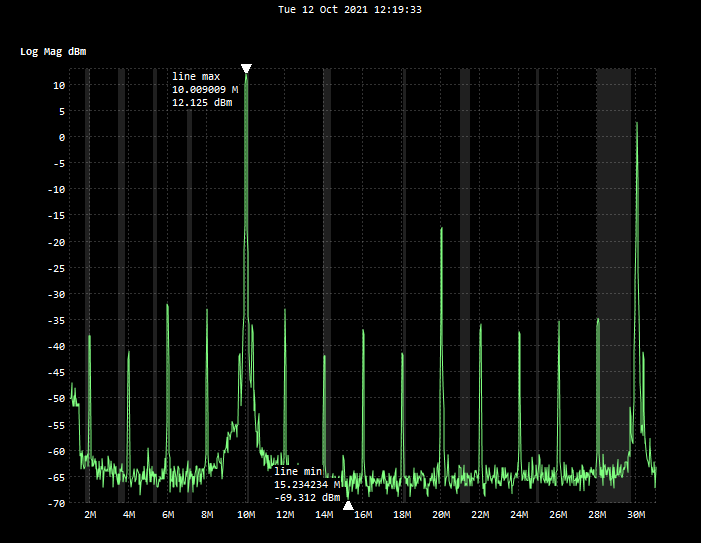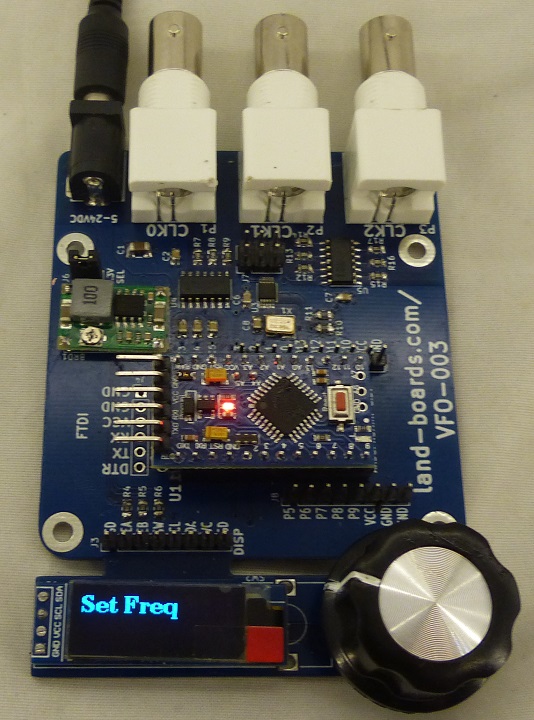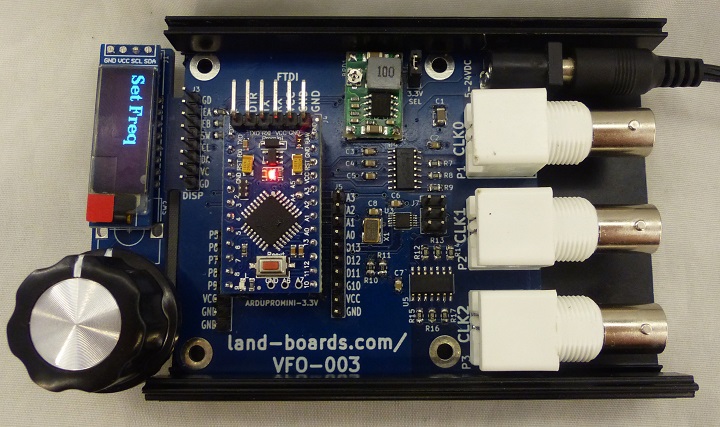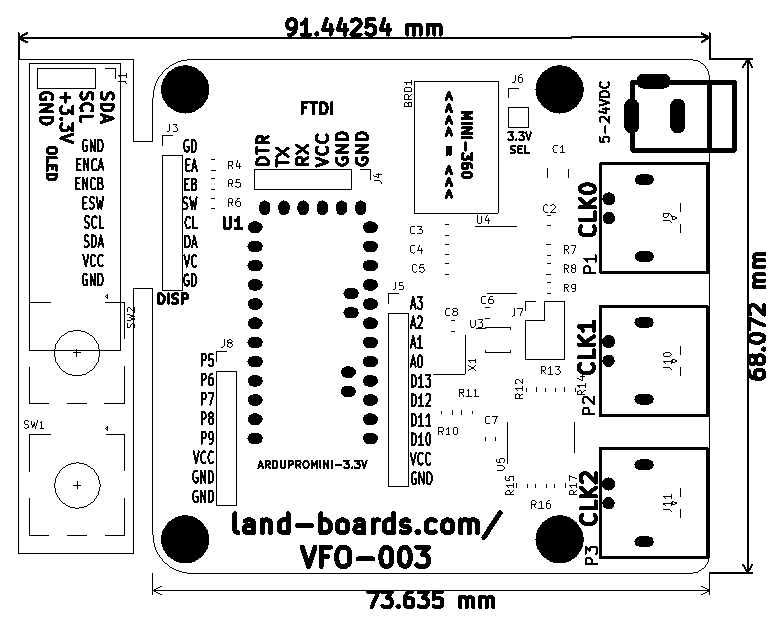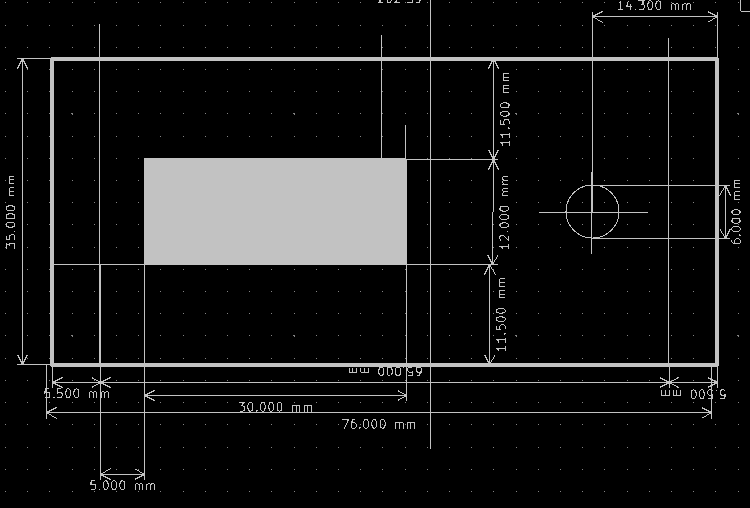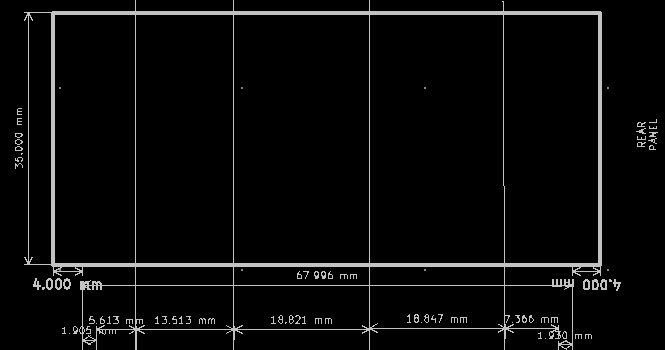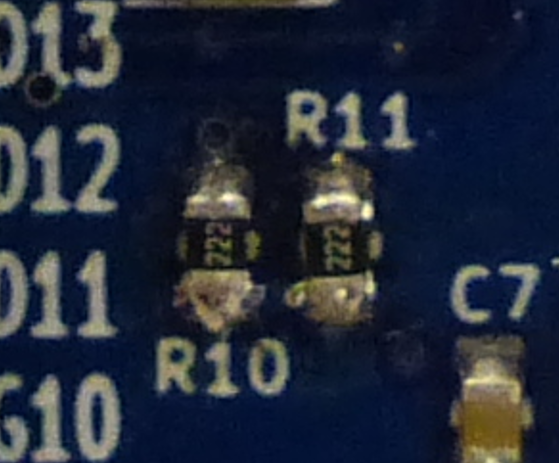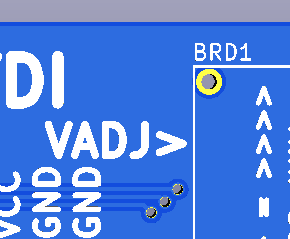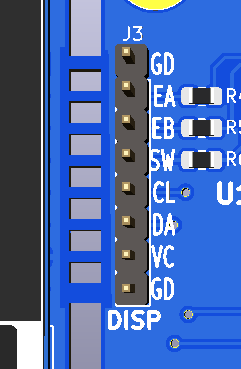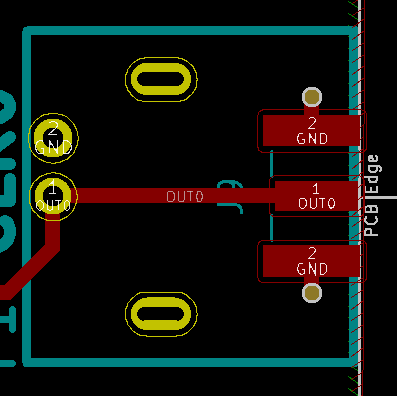Difference between pages "NanoVNA" and "VFO-003"
(Difference between pages)
Jump to navigation
Jump to search
Blwikiadmin (talk | contribs) |
Blwikiadmin (talk | contribs) |
||
| Line 1: | Line 1: | ||
| − | + | [[fILE:VFO-003_P1861_720px.jpg]] | |
| − | + | == Features == | |
| − | + | Software controlled VFO | |
| − | * | + | * Arduino Pro Mini Microprocessor |
| − | * | + | ** 8-bit ATMEGA328 CPU |
| − | * Display | + | ** 8 MHz |
| − | * | + | ** 3.3V I/O |
| − | * | + | * Detachable Rotary Encoder/OLED card |
| − | * | + | ** SSD1306 OLED Display |
| − | * | + | *** I2C Interface |
| − | * | + | ** Rotary encoder |
| − | * | + | * Menu options |
| − | * | + | ** Select between 3 VFOs |
| − | * | + | ** Adjust frequency |
| − | * | + | ** Step sizes: 1Hz, 10 Hz, 100 Hz, 1 KHz, 10 KHz, 100 KHz, 1 MHz, 10 MHz steps (software controllable) |
| − | ** | + | ** Adjust frequency accuracy to 0.01 Hz precision |
| − | * | + | ** Turn VFO Off/On (Off = 3.3V) |
| + | ** Save default values which are loaded at power up | ||
| + | * Si5351A Oscillator | ||
| + | ** 3 Outputs | ||
| + | ** [https://www.mouser.com/ProductDetail/Fox-Abracon/FOX924B-27?qs=%2Fha2pyFaduhq6kU%252Bi5vLrAGjqnvi7J8gxS%252BDxofzmrc%3D 27 MHz TCXO crystal oscillator] | ||
| + | ** I2C Interface | ||
| + | ** [http://www.relmon.com/en/mobile/index.php/list/detail/347.html MS5351M Data Sheet] - Alternate part for Si5351A | ||
| + | *** [http://qrp-labs.com/synth/ms5351m.html MS5351M Evaluation Report by QRP-Labs] | ||
| + | * 3.3V, 50 Ohm outputs | ||
| + | ** +12.6 dBm output | ||
| + | * Power | ||
| + | ** [[Mini360_Buck_Converter|MINI-360 DC/DC Buck regulator]] | ||
| + | ** 5-24 VDC | ||
| + | ** 30mA at 12VDC | ||
| + | * Fits in standard extruded enclosures | ||
| − | === | + | === Arduino Pro Mini === |
| − | + | * [https://www.ebay.com/sch/i.html?_from=R40&_trksid=p2510209.m570.l1313&_nkw=Arduino+Pro+Mini+3.3V&_sacat=0 Ebay search for Arduino Pro Mini 3.3V] | |
| − | * [https://www. | + | * [https://www.amazon.com/s?k=arduino+pro+mini+3.3v&crid=32353SO1QC57M&ref=nb_sb_ss_ts-doa-p_4_16 Amazon search for Arduino Pro Mini 3.3V] |
| − | |||
| − | * [https:// | ||
| − | + | [[File:ArdruinoProMini-EBAY_PART-720px.png]] | |
| − | * | + | === Power === |
| − | * | + | |
| − | * | + | * 5-24 VDC |
| − | * | + | * 30mA at 12VDC |
| − | * | + | * 55mA at 5V |
| − | * | + | * 35mA at 9V |
| − | * | + | * 28mA at 14V |
| − | * | + | * 33mA at 23V |
| − | * | + | |
| − | ** [https:// | + | === TCXO === |
| + | |||
| + | * TXCO requires very little frequency correction | ||
| + | * [https://www.mouser.com/ProductDetail/Fox-Abracon/FOX924B-27?qs=%2Fha2pyFaduhq6kU%252Bi5vLrAGjqnvi7J8gxS%252BDxofzmrc%3D 27 MHz TCXO crystal oscillator] | ||
| + | ** Package / Case: 5 mm x 3.2 mm | ||
| + | ** Frequency: 27 MHz | ||
| + | ** Frequency Stability: 2.5 PPM | ||
| + | ** Supply Voltage - Max: 3.3 V | ||
| + | * [https://www.mouser.com/ProductDetail/Fox-Abracon/FOX924B-25?qs=%2Fha2pyFadui2wJvSeJUfy4U6zwGkGxGt0HiIeYtjWowmwSAvVs76ZA%3D%3D 25 MHz] - Alternate would require software changes | ||
| + | |||
| + | == Connectors == | ||
| + | |||
| + | === J1 - OLED === | ||
| + | |||
| + | * Located on display/encoder board | ||
| + | |||
| + | # SDA | ||
| + | # SCL | ||
| + | # Vcc | ||
| + | # GND | ||
| + | |||
| + | [[file:VFO-003_J1.PNG]] | ||
| + | |||
| + | === J2 - Display Encoder/OLED (Display card) === | ||
| + | |||
| + | * Connect via cable to display/encoder board | ||
| + | |||
| + | # Encoder A | ||
| + | # Encoder B | ||
| + | # Encoder Switch | ||
| + | # SCL | ||
| + | # SDA | ||
| + | # Vcc | ||
| + | # GND | ||
| + | |||
| + | [[file:VFO-003_J2.PNG]] | ||
| + | |||
| + | === J3 - Display Encoder/OLED (Main card) === | ||
| + | |||
| + | * Connect via cable to display/encoder board | ||
| + | |||
| + | # Encoder A | ||
| + | # Encoder B | ||
| + | # Encoder Switch | ||
| + | # SCL | ||
| + | # SDA | ||
| + | # Vcc | ||
| + | # GND | ||
| + | |||
| + | [[file:VFO-003_J3.PNG]] | ||
| + | |||
| + | === J4 - FTDI === | ||
| + | |||
| + | * Can install 1x6 header on the Arduino Pro Mini and not install this | ||
| + | |||
| + | # GND | ||
| + | # GND | ||
| + | # Vcc | ||
| + | # RX | ||
| + | # Tx | ||
| + | # DTR | ||
| + | |||
| + | [[file:VFO-003_J4.PNG]] | ||
| + | |||
| + | === J5 - Arduino A0-A3/C10-D13 === | ||
| + | |||
| + | # A3 | ||
| + | # A2 | ||
| + | # A0 | ||
| + | # D13 | ||
| + | # D12 | ||
| + | # D11 | ||
| + | # D10 | ||
| + | # Vcc (not connected on Rev 1 PCB) | ||
| + | # GND (not connected on Rev 1 PCB) | ||
| + | |||
| + | [[file:VFO-003_J5.PNG]] | ||
| + | |||
| + | === J6 - Disconnect for Mini-360 Power Supply === | ||
| + | |||
| + | * The [[Mini360 Buck Converter]] comes adjusted for a very high output voltage | ||
| + | * Remove jumper to adjust the output voltage to 3.3V without powering the rest of the card | ||
| + | * Install to power the card from the power supply only after adjusting output | ||
| + | |||
| + | [[file:VFO-003_J6.PNG]] | ||
| + | |||
| + | [[file:Mini-360-004.jpg]] | ||
| + | |||
| + | === J7 - Output disconnects === | ||
| + | |||
| + | * Cut rear side trace to disconnect | ||
| + | * Can be used to install external LP filters | ||
| + | * Limited use due to 74AC14 drivers | ||
| + | |||
| + | [[file:VFO-003_J7.PNG]] | ||
| + | |||
| + | === J8 - Arduino P5-P9 === | ||
| + | |||
| + | # P5 | ||
| + | # P6 | ||
| + | # P7 | ||
| + | # P8 | ||
| + | # P9 | ||
| + | # Vcc | ||
| + | # GND | ||
| + | |||
| + | [[file:VFO-003_J8.PNG]] | ||
| + | |||
| + | === J12 - I2C === | ||
| + | |||
| + | [[file:VFO-003_J12.PNG]] | ||
| + | |||
| + | === P1-P3 - Outputs (BNCs) === | ||
| + | |||
| + | == Measurements == | ||
| + | |||
| + | * [[NanoVNA]] | ||
| + | * 10 Mhz signal from the VFO-003 | ||
| + | * 1-100 MHz | ||
| + | |||
| + | [[file:tinysa_LOGMAG_S11_2021-10-12_12-29-43.png]] | ||
| + | |||
| + | [[file:tinysa_LOGMAG_S11_2021-10-12_12-09-58.png]] | ||
| + | |||
| + | === 1-350 MHz scan === | ||
| + | |||
| + | [[file:tinysa_LOGMAG_S11_2021-10-12_12-27-58.png]] | ||
| + | |||
| + | === Harmonic content === | ||
| + | |||
| + | * 10MHz fundamental = +12.25 dBm | ||
| + | * 20MHz harmonic = -16.75 dBm | ||
| + | * 30MHz harmonic = +2.4 dBm | ||
| + | * 50MHz harmonic = -2.1 dBm | ||
| + | |||
| + | [[file:tinysa_LOGMAG_S11_2021-10-12_12-19-33.png]] | ||
| + | |||
| + | == Schematic == | ||
| + | |||
| + | * [https://github.com/land-boards/lb-boards/blob/master/HamRadio/VFO-003/Documents/Schematics/VFO-003_Rev3_Schematic.pdf Rev 3 schematic] | ||
== Software == | == Software == | ||
| − | + | * [https://github.com/land-boards/lb-Arduino-Code/tree/master/LBCards/VFO-003 GitHub Repository] | |
| − | * [https://github.com/ | + | |
| − | + | [[file:VFO-003_P1867-720pxV.jpg]] | |
| − | |||
| − | == | + | === Memory Usage === |
| − | + | * Total Memory usage | |
| − | + | <pre> | |
| − | + | Sketch uses 25970 bytes (84%) of program storage space. Maximum is 30720 bytes. Global variables use 1503 bytes (73%) of dynamic memory, leaving 545 bytes for local variables. Maximum is 2048 bytes. | |
| − | + | </pre> | |
| − | |||
| − | |||
| − | |||
| − | |||
| − | |||
| − | |||
| − | |||
| − | + | * Display code: 10260 | |
| + | * Si5351 code: 12076 | ||
| − | + | ==== Minimal u8g2 code ==== | |
| − | + | <pre> | |
| + | Sketch uses 10260 bytes (33%) of program storage space. Maximum is 30720 bytes. Global variables use 1033 bytes (50%) of dynamic memory, leaving 1015 bytes for local variables. Maximum is 2048 bytes. | ||
| + | </pre> | ||
| − | * | + | * Code |
| − | + | <pre> | |
| + | void setup(void) | ||
| + | { | ||
| + | u8g2.begin(); | ||
| − | + | } | |
| − | + | void loop(void) | |
| + | { | ||
| + | printStringToOLED("VFO-003"); | ||
| + | } | ||
| − | * | + | void printStringToOLED(char * charStr) |
| + | { | ||
| + | u8g2.clearBuffer(); | ||
| + | u8g2_prepare(); | ||
| + | u8g2.drawStr( 0, 0, charStr); | ||
| + | u8g2.sendBuffer(); | ||
| + | } | ||
| − | + | // u8g2_prepare() | |
| + | // Setup the screen font, etc | ||
| + | // List of fonts | ||
| + | // https://github.com/olikraus/u8g2/wiki/fntlist8#u8g2-fonts-capital-a-height-38 | ||
| + | void u8g2_prepare(void) | ||
| + | { | ||
| + | u8g2.setFont(u8g2_font_t0_11b_tf); // 8 Pixel tall font | ||
| + | u8g2.setFontRefHeightExtendedText(); | ||
| + | u8g2.setDrawColor(1); | ||
| + | u8g2.setFontPosTop(); | ||
| + | u8g2.setFontDirection(0); | ||
| + | } | ||
| + | </pre> | ||
| − | + | ==== Minimal Si5351 code ==== | |
| − | < | + | <pre> |
| + | Sketch uses 12076 bytes (39%) of program storage space. Maximum is 30720 bytes. Global variables use 378 bytes (18%) of dynamic memory, leaving 1670 bytes for local variables. Maximum is 2048 bytes. | ||
| + | </pre> | ||
| − | + | <pre> | |
| + | #include <Arduino.h> | ||
| + | #include "si5351.h" | ||
| − | + | // Constructors | |
| + | Si5351 si5351; | ||
| + | // End of constructor list | ||
| − | + | void setup(void) | |
| + | { | ||
| + | unsigned long VFO_0_Freq; | ||
| + | unsigned long VFO_1_Freq; | ||
| + | unsigned long VFO_2_Freq; | ||
| + | bool i2c_found; | ||
| + | VFO_0_Freq = 14000000; | ||
| + | VFO_0_Freq = 14000000; | ||
| + | VFO_0_Freq = 14000000; | ||
| + | // Si8351 initialiation | ||
| + | si5351.init(SI5351_CRYSTAL_LOAD_6PF, 27000000, 0); | ||
| + | si5351.set_freq(VFO_0_Freq, SI5351_CLK0); | ||
| + | si5351.set_freq(VFO_1_Freq, SI5351_CLK1); | ||
| + | si5351.set_freq(VFO_2_Freq, SI5351_CLK2); | ||
| + | si5351.update_status(); | ||
| + | si5351.set_correction(0, SI5351_PLL_INPUT_XO); | ||
| + | si5351.drive_strength(SI5351_CLK0,SI5351_DRIVE_8MA); | ||
| + | si5351.drive_strength(SI5351_CLK1,SI5351_DRIVE_8MA); | ||
| + | si5351.drive_strength(SI5351_CLK2,SI5351_DRIVE_8MA); | ||
| + | } | ||
| − | + | void loop(void) | |
| + | { | ||
| + | } | ||
| + | </pre> | ||
| − | + | === Feature Adds === | |
| − | [ | + | * [https://github.com/pavelmc/FT857d CAT control] |
| − | + | == Mechanicals/Enclosure == | |
| − | + | * Detachable Front Panel OLED with Rotary Encoder | |
| − | + | [[file:VFO-003_P1871_720px.jpg]] | |
| − | [https://www. | + | * Designed to fit into Aluminum Project Box Enclosure DIY 100*76*35mm - [https://www.ebay.com/sch/i.html?_from=R40&_trksid=p2334524.m570.l1313&_nkw=100*76*35mm+aluminum&_sacat=0&LH_TitleDesc=0&_odkw=100*76*35mm+Aluminum+PCB+Instrument+Box+Enclosure+Electronic+Project+Case+Set&_id=174408274566 ebay search] |
| − | + | [[file:VFO-003_CAD_Dimensioned.PNG]] | |
| − | + | [[file:VFO-003_FrontPanel_Holes.PNG]] | |
| − | + | [[file:VFO-003_RearPanel_Holes.PNG]] | |
| − | + | == Rev 1 Board Issues List == | |
| − | + | No major issues | |
| − | + | * J5-9 and J5-10 are missing connections | |
| + | ** Add wires on reverse side of the PCB if needed | ||
| + | * Note orientation of I2C termination resistors | ||
| + | ** Installed sideways by accident on first build | ||
| − | + | [[file:Rev1-Rework_R10,R11.PNG]] | |
| − | + | * Note orientation of Mini360 | |
| + | ** Put on backwards on first build | ||
| + | ** Always use a current limited power supply (I did, no damage) | ||
| + | ** Always adjust Mini360 with 3.3V SEL jumper removed | ||
| + | ** Solder in with short leads - space up a bit to allow rework | ||
| + | ** Orientation is with inductor towards edge of card | ||
| − | + | [[file:Rev1-Rework_Mini360_Oientation.PNG]] | |
| − | + | == Rev 3 Design == | |
| − | + | * Adds J12, I2C connector | |
| + | ** Use with I2C Peripheral like port expanders | ||
| − | + | [[file:Rev3-_J12_I2C.PNG]] | |
| − | + | * Add silkscreen, "VADJ>" pointing to the adjustment pot on Mini360 | |
| − | + | [[file:Rev2-Rework_Mini360_VADJ.PNG]] | |
| − | + | * Add breakaways for Front Panel to make it easier to separate | |
| − | + | [[file:Rev3-_OLED_Breakaways.PNG]] | |
| − | + | * Switch to 0.1" pitch SMA edge launch connectors | |
| − | + | [[file:Rev3-_SMA_Smaller.PNG]] | |
| − | + | == Assembly Sheet / Parts List == | |
| − | + | [[VFO-003 Assembly Sheet - Rev 1]] | |
Revision as of 00:05, 15 October 2021
Contents
Features
Software controlled VFO
- Arduino Pro Mini Microprocessor
- 8-bit ATMEGA328 CPU
- 8 MHz
- 3.3V I/O
- Detachable Rotary Encoder/OLED card
- SSD1306 OLED Display
- I2C Interface
- Rotary encoder
- SSD1306 OLED Display
- Menu options
- Select between 3 VFOs
- Adjust frequency
- Step sizes: 1Hz, 10 Hz, 100 Hz, 1 KHz, 10 KHz, 100 KHz, 1 MHz, 10 MHz steps (software controllable)
- Adjust frequency accuracy to 0.01 Hz precision
- Turn VFO Off/On (Off = 3.3V)
- Save default values which are loaded at power up
- Si5351A Oscillator
- 3 Outputs
- 27 MHz TCXO crystal oscillator
- I2C Interface
- MS5351M Data Sheet - Alternate part for Si5351A
- 3.3V, 50 Ohm outputs
- +12.6 dBm output
- Power
- MINI-360 DC/DC Buck regulator
- 5-24 VDC
- 30mA at 12VDC
- Fits in standard extruded enclosures
Arduino Pro Mini
Power
- 5-24 VDC
- 30mA at 12VDC
- 55mA at 5V
- 35mA at 9V
- 28mA at 14V
- 33mA at 23V
TCXO
- TXCO requires very little frequency correction
- 27 MHz TCXO crystal oscillator
- Package / Case: 5 mm x 3.2 mm
- Frequency: 27 MHz
- Frequency Stability: 2.5 PPM
- Supply Voltage - Max: 3.3 V
- 25 MHz - Alternate would require software changes
Connectors
J1 - OLED
- Located on display/encoder board
- SDA
- SCL
- Vcc
- GND
J2 - Display Encoder/OLED (Display card)
- Connect via cable to display/encoder board
- Encoder A
- Encoder B
- Encoder Switch
- SCL
- SDA
- Vcc
- GND
J3 - Display Encoder/OLED (Main card)
- Connect via cable to display/encoder board
- Encoder A
- Encoder B
- Encoder Switch
- SCL
- SDA
- Vcc
- GND
J4 - FTDI
- Can install 1x6 header on the Arduino Pro Mini and not install this
- GND
- GND
- Vcc
- RX
- Tx
- DTR
J5 - Arduino A0-A3/C10-D13
- A3
- A2
- A0
- D13
- D12
- D11
- D10
- Vcc (not connected on Rev 1 PCB)
- GND (not connected on Rev 1 PCB)
J6 - Disconnect for Mini-360 Power Supply
- The Mini360 Buck Converter comes adjusted for a very high output voltage
- Remove jumper to adjust the output voltage to 3.3V without powering the rest of the card
- Install to power the card from the power supply only after adjusting output
J7 - Output disconnects
- Cut rear side trace to disconnect
- Can be used to install external LP filters
- Limited use due to 74AC14 drivers
J8 - Arduino P5-P9
- P5
- P6
- P7
- P8
- P9
- Vcc
- GND
J12 - I2C
P1-P3 - Outputs (BNCs)
Measurements
- NanoVNA
- 10 Mhz signal from the VFO-003
- 1-100 MHz
1-350 MHz scan
Harmonic content
- 10MHz fundamental = +12.25 dBm
- 20MHz harmonic = -16.75 dBm
- 30MHz harmonic = +2.4 dBm
- 50MHz harmonic = -2.1 dBm
Schematic
Software
Memory Usage
- Total Memory usage
Sketch uses 25970 bytes (84%) of program storage space. Maximum is 30720 bytes. Global variables use 1503 bytes (73%) of dynamic memory, leaving 545 bytes for local variables. Maximum is 2048 bytes.
- Display code: 10260
- Si5351 code: 12076
Minimal u8g2 code
Sketch uses 10260 bytes (33%) of program storage space. Maximum is 30720 bytes. Global variables use 1033 bytes (50%) of dynamic memory, leaving 1015 bytes for local variables. Maximum is 2048 bytes.
- Code
void setup(void)
{
u8g2.begin();
}
void loop(void)
{
printStringToOLED("VFO-003");
}
void printStringToOLED(char * charStr)
{
u8g2.clearBuffer();
u8g2_prepare();
u8g2.drawStr( 0, 0, charStr);
u8g2.sendBuffer();
}
// u8g2_prepare()
// Setup the screen font, etc
// List of fonts
// https://github.com/olikraus/u8g2/wiki/fntlist8#u8g2-fonts-capital-a-height-38
void u8g2_prepare(void)
{
u8g2.setFont(u8g2_font_t0_11b_tf); // 8 Pixel tall font
u8g2.setFontRefHeightExtendedText();
u8g2.setDrawColor(1);
u8g2.setFontPosTop();
u8g2.setFontDirection(0);
}
Minimal Si5351 code
Sketch uses 12076 bytes (39%) of program storage space. Maximum is 30720 bytes. Global variables use 378 bytes (18%) of dynamic memory, leaving 1670 bytes for local variables. Maximum is 2048 bytes.
#include <Arduino.h>
#include "si5351.h"
// Constructors
Si5351 si5351;
// End of constructor list
void setup(void)
{
unsigned long VFO_0_Freq;
unsigned long VFO_1_Freq;
unsigned long VFO_2_Freq;
bool i2c_found;
VFO_0_Freq = 14000000;
VFO_0_Freq = 14000000;
VFO_0_Freq = 14000000;
// Si8351 initialiation
si5351.init(SI5351_CRYSTAL_LOAD_6PF, 27000000, 0);
si5351.set_freq(VFO_0_Freq, SI5351_CLK0);
si5351.set_freq(VFO_1_Freq, SI5351_CLK1);
si5351.set_freq(VFO_2_Freq, SI5351_CLK2);
si5351.update_status();
si5351.set_correction(0, SI5351_PLL_INPUT_XO);
si5351.drive_strength(SI5351_CLK0,SI5351_DRIVE_8MA);
si5351.drive_strength(SI5351_CLK1,SI5351_DRIVE_8MA);
si5351.drive_strength(SI5351_CLK2,SI5351_DRIVE_8MA);
}
void loop(void)
{
}
Feature Adds
Mechanicals/Enclosure
- Detachable Front Panel OLED with Rotary Encoder
- Designed to fit into Aluminum Project Box Enclosure DIY 100*76*35mm - ebay search
Rev 1 Board Issues List
No major issues
- J5-9 and J5-10 are missing connections
- Add wires on reverse side of the PCB if needed
- Note orientation of I2C termination resistors
- Installed sideways by accident on first build
- Note orientation of Mini360
- Put on backwards on first build
- Always use a current limited power supply (I did, no damage)
- Always adjust Mini360 with 3.3V SEL jumper removed
- Solder in with short leads - space up a bit to allow rework
- Orientation is with inductor towards edge of card
Rev 3 Design
- Adds J12, I2C connector
- Use with I2C Peripheral like port expanders
- Add silkscreen, "VADJ>" pointing to the adjustment pot on Mini360
- Add breakaways for Front Panel to make it easier to separate
- Switch to 0.1" pitch SMA edge launch connectors
